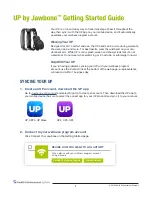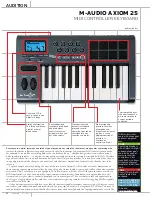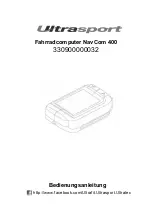
6-8
Program Mode
KB3 Program Structure
You
may
find
it
more
convenient
to
use
the
local
keyboard
channel.
In
this
case,
the
PC3K
remaps
incoming
MIDI
to
the
PC3K’s
current
channel,
so
in
Program
mode,
you’ll
always
play
the
program
on
the
PC3K’s
current
channel.
Incoming
MIDI
also
gets
sent
to
the
PC3K’s
MIDI
Out
port.
On
the
other
hand,
in
this
case
your
MIDI
source’s
transmitting
channel
must
match
the
PC3K’s
local
keyboard
channel
for
anything
to
work.
Furthermore,
for
KB3
programs,
some
of
the
MIDI
Controller
numbers
listed
in
Table 6
‐
3
won’t
necessarily
work.
Things
are
a
bit
different
for
playing
setups.
In
this
case,
you
must
use
the
local
keyboard
channel
to
be
able
to
play
and
control
all
of
the
setup’s
zones.
Set
LocalKbd
to
match
the
channel
your
external
MIDI
source
is
using
(so
if,
for
example,
your
MIDI
source
transmits
on
Channel
1,
set
LocalKbd
to
1
).
All
MIDI
information
that
the
PC3K
receives
on
the
local
keyboard
channel
gets
remapped
to
the
channels
and
control
destinations
used
by
the
zones
in
the
setup.
The
PC3K
also
remaps
certain
MIDI
Controller
messages
that
it
receives
on
the
local
keyboard
channel,
so
that
they
correspond
(in
most
cases)
to
the
default
assignments
for
the
PC3K’s
physical
controllers
(Mod
Wheel,
sliders,
ribbons,
etc.).
While
this
ensures
that
the
physical
controllers
work
in
a
consistent
and
relatively
standard
fashion
for
most
setups
and
VAST
programs,
it
necessitates
a
few
adjustments
to
make
incoming
MIDI
Controller
messages
control
the
KB3
features
listed
in
Table 6
‐
3.
Without
these
adjustments,
some
of
the
KB3
features
won’t
respond
to
MIDI
Controller
messages—this
is
true
when
you’re
playing
programs
as
well
as
when
you’re
playing
setups.
To
make
everything
work
properly,
you
need
to
make
sure
that
all
the
appropriate
physical
controllers
are
assigned
for
KB3
control.
Physical
controller
assignments
are
handled
by
setups,
and
are
defined
by
parameters
on
several
pages
in
the
Setup
Editor.
Each
zone
of
a
setup
has
its
own
controller
assignments.
Programs
don’t
have
controller
assignments,
so
they
“borrow”
them
from
a
special
setup
that’s
reserved
for
that
purpose.
This
setup
is
called
the
Control
Setup;
it’s
determined
by
the
value
of
the
ControlSetup
parameter
(on
the
TRANSMIT
page
in
MIDI
mode).
You
can
read
about
Control
Setups
in
detail
on
page 6
‐
9.
When
you’re
playing
a
setup
on
the
local
keyboard
channel,
each
zone
that
uses
a
KB3
program
must
have
the
appropriate
physical
controller
assignments.
When
you’re
playing
a
KB3
program,
Zone
1
of
the
Control
Setup
must
have
the
appropriate
physical
controller
assignments.
One
final
word—for
now—about
using
the
local
keyboard
channel:
all
the
MIDI
information
received
on
the
local
keyboard
channel
also
gets
sent—
after
being
remapped
—to
the
PC3K’s
MIDI
Out
port.
There’s
a
discussion
of
the
local
keyboard
channel
in
Chapter
10.
Содержание PC3K6
Страница 24: ...1 6 Introduction Options...
Страница 50: ...4 4 The Operating Modes Using the Modes...
Страница 58: ...5 8 Editing Conventions Special Button Functions...
Страница 130: ...6 72 Program Mode Programming Tips...
Страница 202: ...7 72 Setup Mode Recording A Setup To Song Mode...
Страница 206: ...8 4 Quick Access Mode The QA Editor...
Страница 232: ...9 26 Effects Mono Algorithms...
Страница 268: ...11 18 Master Mode Preview Sample PRVIEW...
Страница 302: ...12 34 Song Mode and the Song Editor Song Editor The EVENT Page...
Страница 328: ...14 14 Keymap and Sample Editing Editing Samples...
Страница 334: ...B 4...
Страница 370: ...D 32 PC3K Objects V 1 31 Effect Chains...
Страница 372: ...E 2 PC3K Legacy File Conversion Object Types and Conversion Details...
















































